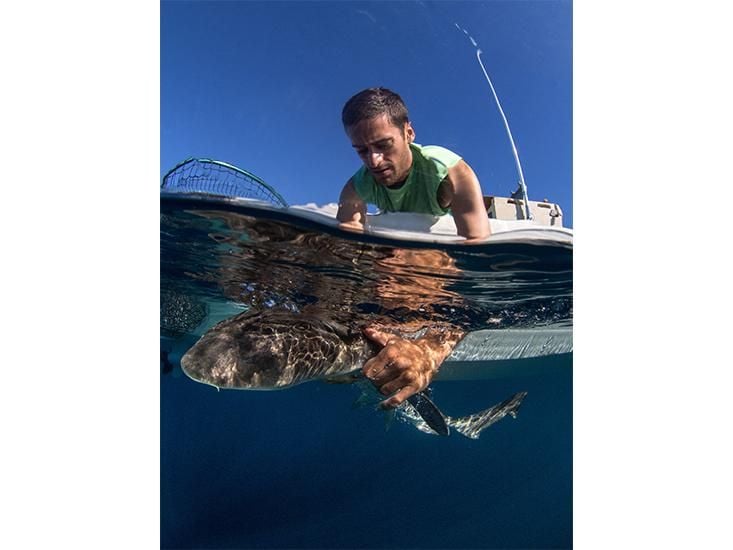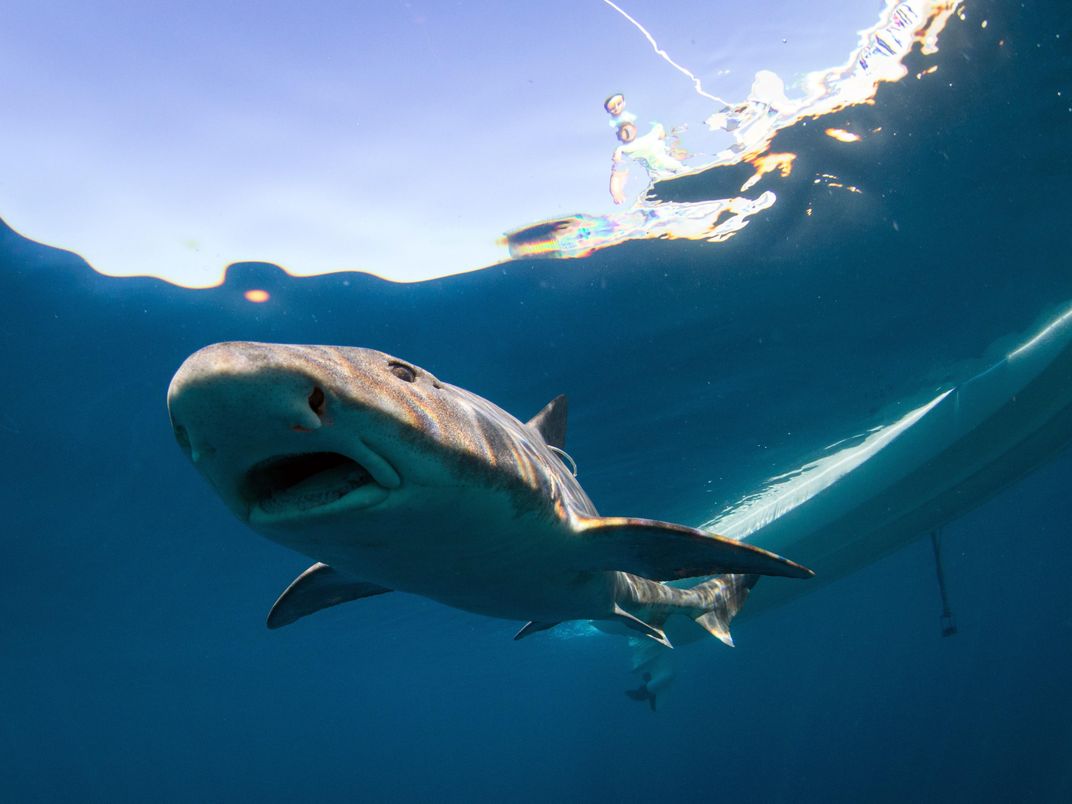Leopard Sharks Navigate With Their Noses
After being kidnapped and dropped off at sea, the sharks picked up on olfactory cues to find their way back home
/https://tf-cmsv2-smithsonianmag-media.s3.amazonaws.com/filer/fc/e9/fce9385b-fd50-420a-aff0-b0755b9adeed/leopard_2_-_kyle_mcburnie.jpeg)
According to popular lore, sharks can detect a single drop of blood spilled in the ocean. While this is an exaggeration, sharks do possess an incredibly keen sense of smell. Some species are able to sniff out blood at a concentration of about one part per million, and others can smell even tiny amounts of oils from their prey at distances of several hundred feet.
As if their olfactory hunting prowess wasn’t impressive enough, now studies of wild leopard sharks reveal that their noses also serve another purpose: navigation.
“While the knowledge that sharks home—or know where they are going—is not new, the mechanisms they use to navigate are largely unknown,” says Yannis Papastamatiou, a shark ecologist at Florida International University who was not involved in the research.
“Olfaction has not received as much attention in navigation studies, but now we have evidence that smell is likely to play a role in some of their navigational capabilities.”
Other animals, including salmon and some birds and insects, use smell to navigate, and the structure of shark brains had previously hinted at their smelly secret. For certain sharks, the olfactory bulb—the part of the brain that processes scent-related stimuli—doesn’t scale in proportion to body size.
A shark species that weighs twice as much as another species may not have an olfactory bulb that weighs twice as much. Instead, the olfactory bulb’s size seems to correlate with how great of a demand the species has for navigation, with animals that travel long distances and along straight lines possessing larger olfactory bulbs.
Until now, however, those correlations had not been explored experimentally in the open ocean. So Andrew Nosal, a postdoctoral researcher at the Birch Aquarium and Scripps Institution of Oceanography, took to the seas in search of leopard sharks. These small predators spend the majority of their time in shallow coastal waters rather than the open ocean, and Nosal and his colleagues knew that the sharks aggregate each year at a site near La Jolla, just north of San Diego, making them easy to find.
The researchers trapped 26 leopard sharks in total. All of the sharks underwent the same post-capture procedure of being flipped onto their backs—a position that triggers a hypnosis-like state—and having forceps gently inserted into their nostrils, or nares.
Of the group, 11 sharks has their noses stuffed with cotton balls soaked in a Vaseline-like substance, which blocks their sense of smell. Sharks use their noses only to smell, not to breathe, so the animals were in no danger of suffocating. The rest of the group got the forceps treatment but no cotton balls.
All of the sharks were equipped with acoustic transmitters via a dissolvable release mechanism, which detached after about four hours. The transmitters could then float to the surface so the team could scoop them up.

The researchers boated the confused animals out to sea, being careful to ensure the sharks didn’t have any external clues during the outward journey that would help them get back home.
“We didn’t want them to just follow the breadcrumbs back,” Nosal says. The boat spun in several figure eights instead of just bee-lining from the shore. Also, the team hung a strong magnet in the middle of the sharks’ holding tank to confuse any geomagnetic signals, and they covered the tank to hinder any visual cues.
Once the team reached about 10.5 miles from the capture site, they released the sharks in random directions, being careful not to simply point them all toward the coast.
By the time their acoustic transmitters popped off, the majority of the sharks eventually made it back closer to shore, regardless of whether their noses were plugged. Some, including the unplugged sharks, initially headed in the wrong direction, but within 30 minutes they made U-turns and righted themselves.
“These leopard sharks could be basically kidnapped from their home, brought into the middle of the ocean and, upon release, find their way back to shore along an almost perfectly straight path,” Nosal says. “It was pretty amazing to us.”
There were differences between the two groups, however. The sharks with the blocked noses swam in “significantly more torturous paths,” the researchers report this week in PLOS ONE. They also wound up significantly farther from shore by the time their transmitters popped up.
These differences indicate that olfaction does play a role in navigation. But given that most of the sharks headed in the correct direction eventually, there must be other contributing factors. The sharks could be using geomagnetic or acoustic cues, such as the low frequency sound of waves crashing on shore, to bolster their navigational skills.
The researchers are also not sure which chemical cues the sharks are homing in on to direct them back to the coast. Salmon use dissolved amino acids, for example, which occur in different gradients as concentrations of sea life change closer to shore. It could be that the sharks are picking up on those organic compounds as well.
Although the study only looked at leopard sharks, the researchers suspect their findings might apply to other species that navigate similar distances, on the order of a few to tens of miles. For those that cross entire oceans, however, other senses are likely at play.
“On small scales, I think olfaction is probably pretty commonly used by other sharks,” Nosal says. “But this is the first step. Now we need to figure out exactly what they’re cuing in on.”

/https://tf-cmsv2-smithsonianmag-media.s3.amazonaws.com/accounts/headshot/Rachel-Nuwer-240.jpg)
/https://tf-cmsv2-smithsonianmag-media.s3.amazonaws.com/accounts/headshot/Rachel-Nuwer-240.jpg)